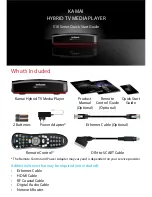
PAQ
65D
PAQ
B-258
・All specifications are subject to change without notice.
1.2 Output derating by MOSFET Q15
It is recommended to use the output derating curve by
measuring MOSFET Q15 temperature if there is difficulty
in taking the actual airflow and ambient temperature in ac-
tual application. Fig.1-10 shows the position of MOSFET
Q15 for thermal measurement. Connect a thermocouple
at the center of this device body. Make sure that at any
operating condition, the temperature for this device should
not exceed 125℃ as shown in Figure 1-11 output derating
curve. If exceeded, the Over Thermal Protection (OTP) of
power module will operates and output will shutdown.
Input
Output
TOP VIEW
MOSFET Q15
Fig.1-10: MOSFET Q15 Position
● Output derating curve with respect to Q15
120
100
80
60
40
20
0
0
20
40
60
80
100 120
125
140
Q15 Temperature (℃)
Total power (%)
Fig.1-11: PAQ65D48 Output Derating curve by MOSFET
Q15 Temperature
2 Mounting Method
(a)Prohibition area of pattern wiring
For the standard model, avoid wiring pattern on PCB
in shaded area, as shown in Figure 2-1 as it may
cause insulation problem. Since the power module
may be influenced by noise, care must be taken when
wiring the signal line on the unshaded area. Note that
for /C option, it is not necessary to have kept out area
for PCB pattern.
7.6 6.1 8.0 4.9 10.2
+Vin
TOP VIEW
Vo1
Vo2
TRM1 GND TRM2
CNT
-Vin
18.2
36.8
5.3
4.
3
6.
9
8.
7
38
.0
57
.9
10
.4
4.
8
4.
1
10
.1
Fig.2-1 : Prohibition area of wiring pattern
(b)Mounting hole on PCB
Below is the recommended diameter of hole and land of PCB.
Type
Terminal Pin
Hole Diameter
Land Diameter
PAQ65D48
φ 1.0mm
φ 1.3mm
φ 2.8mm
For position of the holes, see outline drawing of the
power module.
(c)Recommended Material of PCB
Recommended materials of the printed circuit board is
double sided glass epoxy with through holes. (thick-
ness: t=1.6mm)
(d) Output Pattern Width
When several to tens amperes of current flows to
output pattern, voltage would drop and heat genera-
tion would be higher for narrow pattern. Relationship
between current and pattern width changes depend-
ing on material of printed circuit board, thickness of
conductor and temperature rise allowance. Fig. 2-2
shows an example of a 35μm copper glass epoxy
printed circuit board. For example, when 5A of current
flows and temperature rise below 10℃ are expected,
pattern width shall be more than 4.2mm with 35µm
copper plate (generally 1mm/A is standard).
Confirmation is definitely necessary for designing be-
cause characteristics shown in Fig. 2-2 depend on
manufacturers of printed circuit board.
Pattern Width (mm)
current (A)
14
12
10
8
6
4
2
0
1
2
3
4
5
60℃
40℃
20℃
10℃
Fig.2-2 Characteristic of current allowance
3 Recommended Soldering Condition
Recommended soldering temperature is as follows.
(1)Soldering dip:
260℃ within 6 seconds
Pre-heat condition: 110℃ 30 - 40 seconds
(2) Soldering iron:
350℃ within 3seconds
4 Recommended Cleaning Condition
Recommended cleaning condition after soldering is as fol-
lows.
●Cleaning solvent: IPA (isopropyl alcohol)
●Cleaning Procedure:Use brush and dry the solvent com-
pletely.
Note: For other cleaning methods, contact us.
Summary of Contents for PAQ50S48-1R2
Page 36: ...B 260...



































